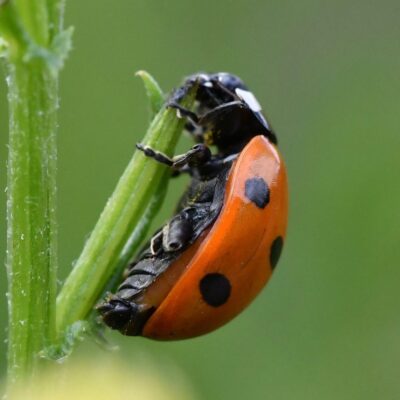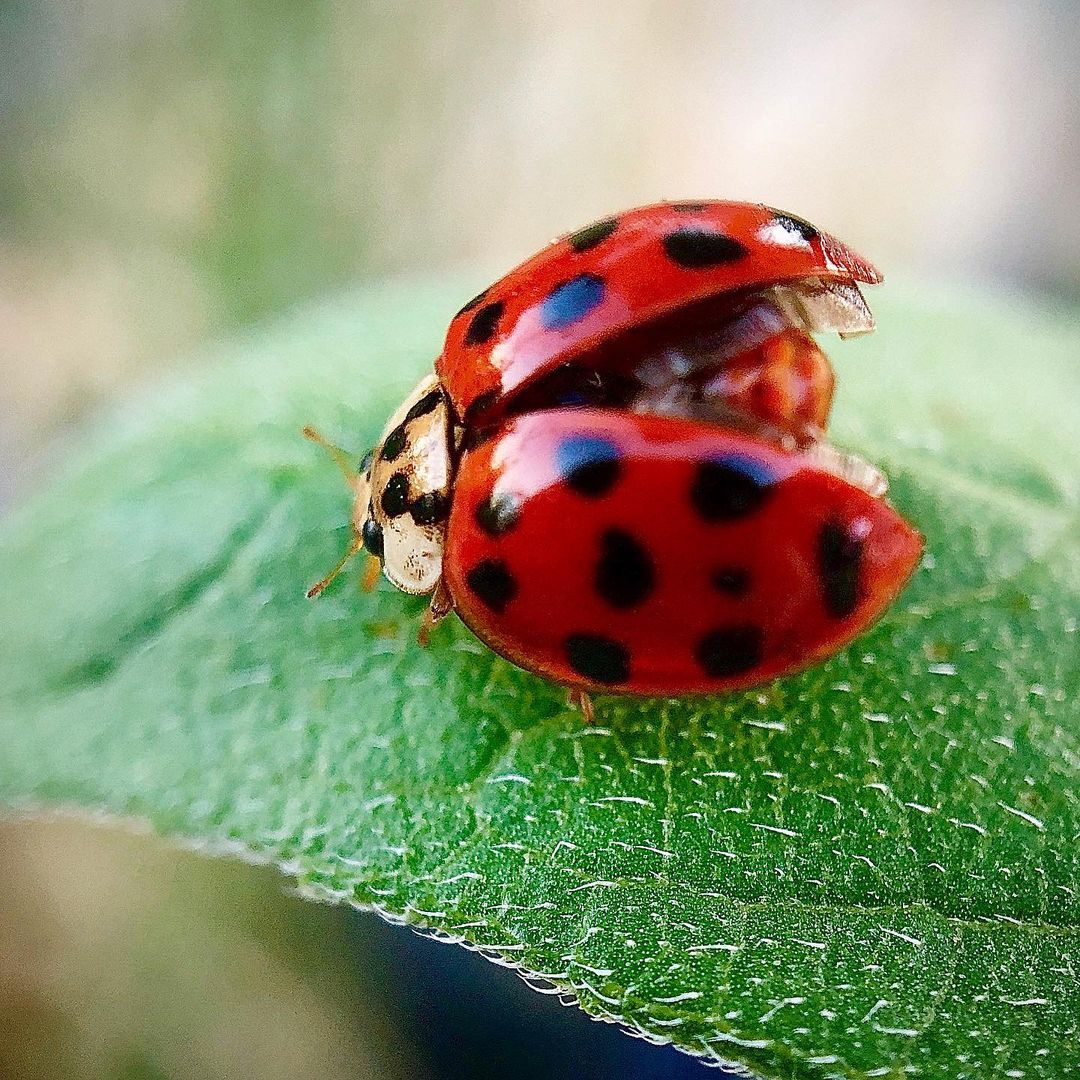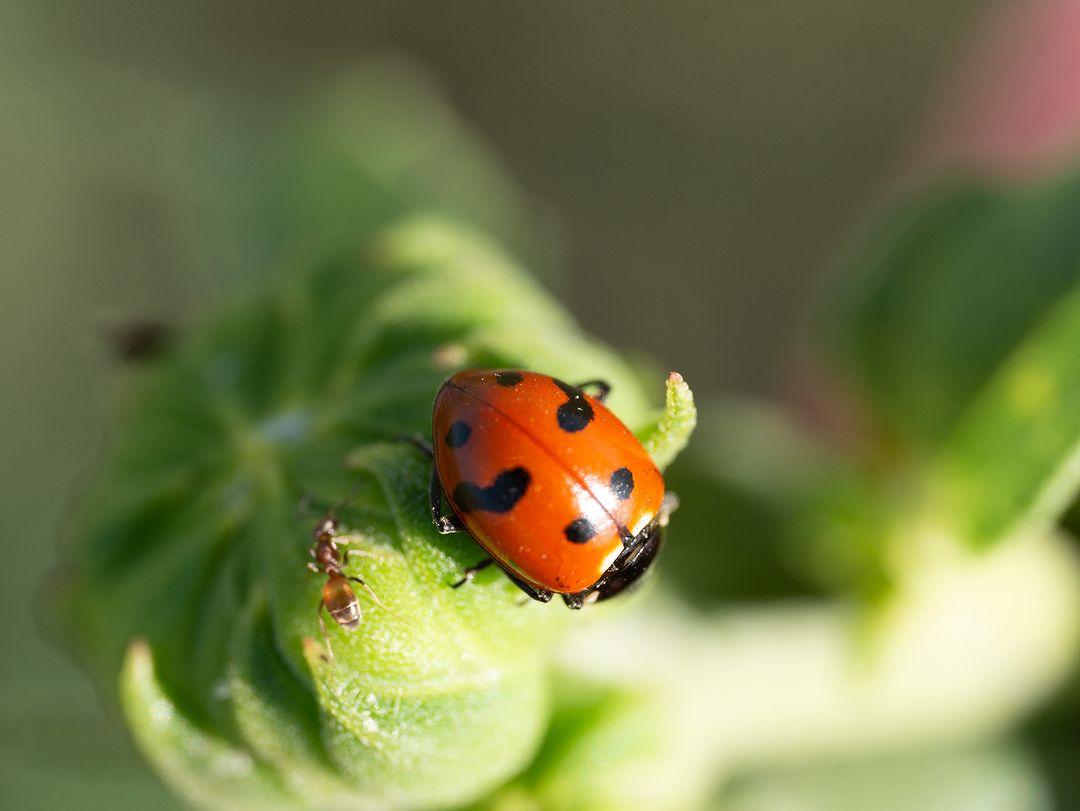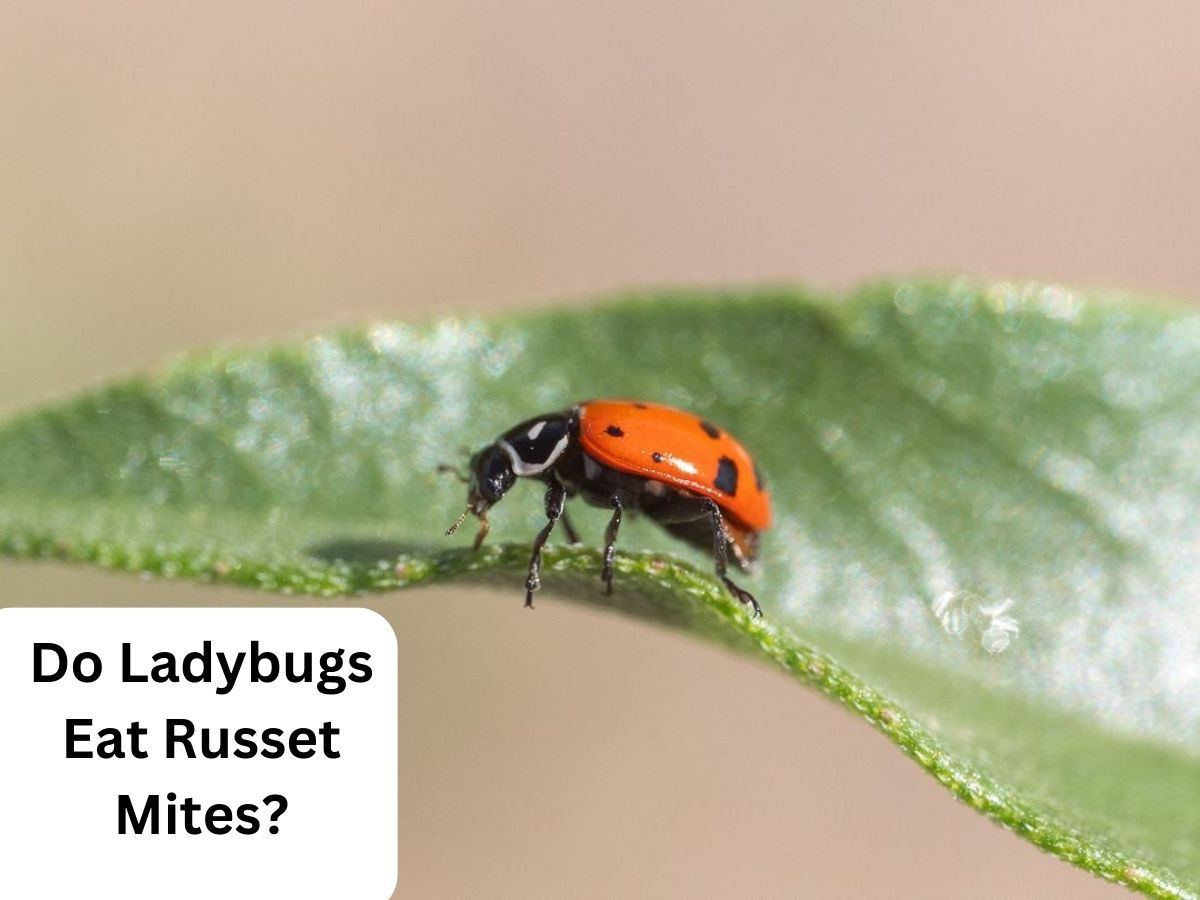Ever wondered if those charming ladybugs flitting around your garden have a taste for russet mites? As you wage a relentless battle against these pesky intruders, the answer might just lie in nature’s most charming defenders. Ladybugs, those dainty yet daring insects, have long been celebrated for their role in pest control. But when it comes to the elusive russet mites, do ladybugs eat russet mites?
In a world where gardens are both havens of tranquility and battlegrounds against pests, understanding the dynamics between ladybugs and russet mites becomes crucial. Russet mites, those microscopic nuisances capable of wreaking havoc on your plants, can leave even seasoned gardeners scratching their heads. But fear not, for in the heart of this insect showdown lies a glimmer of hope: ladybugs, with their vibrant colors and voracious appetites.
So, let’s cut to the chase: Do ladybugs eat russet mites? The short answer is yes, they do! Ladybugs are not just a pretty face in the garden; they’re formidable predators with a preference for soft-bodied pests like aphids, mealybugs, and, you guessed it, russet mites. Armed with powerful mandibles and a keen sense of smell, these charming creatures embark on a mission to keep your plants safe from the microscopic threats lurking beneath the leaves.
But as with any tale in the garden, there’s more to the story. While ladybugs hold promise as a natural solution to russet mite woes, the practicality of their role and the nuances of their interaction with these tiny adversaries deserve a closer look.
So, join us on a journey as we explore the intricate world of ladybugs and their appetite for russet mites. Get ready to uncover the secrets of this captivating battle and discover whether ladybugs truly hold the key to restoring harmony to your garden haven.
Understanding Russet Mites
In the world of gardening, it’s often the tiniest intruders that cause the most significant havoc. Russet mites, those minuscule troublemakers invisible to the naked eye, have mastered the art of silent infiltration and wreaking havoc on unsuspecting plants.
Let’s delve into the secretive world of these microscopic pests, exploring their impact, the telltale signs of their presence, and the challenges growers face in their relentless battle.
Russet mites, known scientifically as Aceria anthocoptes, might be small, but their impact on plants is far from insignificant. These arachnid relatives measure a mere 0.2 millimeters in size, making them nearly impossible to spot without a magnifying lens.
However, their effects are unmistakable: they puncture plant cells to feed on the contents, leading to a characteristic stippling or bronzing of leaves. The result? Discolored foliage, stunted growth, and a potential reduction in fruit production.
Signs and Symptoms of Russet Mite Infestations
Detecting russet mites requires a keen eye attuned to the subtle changes in your garden. Keep a lookout for leaves that exhibit a bronzed or silvery sheen, as if they’ve been kissed by a metallic hue.
These early signs often indicate russet mite feeding damage. As the infestation progresses, leaves might curl, wilt, or drop prematurely. In severe cases, the damage becomes a chorus of distress, rendering plants vulnerable to secondary infections and reducing their overall vitality.
As the battle against these elusive intruders continues, growers are pushed to explore innovative strategies to safeguard their gardens.
But fear not, for there’s hope on the horizon – the ladybug army stands ready, and their potential to take on russet mites might just be the secret weapon gardeners have been waiting for.
So, as we navigate the intricate dance between ladybugs and russet mites, remember that every garden challenge is an opportunity to unravel the mysteries of nature’s delicate balance.

Meet the Ladybug Army
Step into any garden, and you’re likely to catch a glimpse of these captivating creatures with their bold hues and charming polka dots. Ladybugs, those beloved icons of the insect world, are more than just a delightful sight; they’re a testament to nature’s genius at work.
As we uncover the enchanting world of these tiny defenders, you’ll discover how their vibrant appearance, gentle demeanor, and insatiable appetite for pests make them a true force to be reckoned with in the realm of gardening.
Ladybugs, also known as ladybirds or lady beetles, are a testament to nature’s artistic prowess. Their vivid reds, sunny yellows, and fiery oranges stand out against the lush backdrop of leaves and petals.
These hues serve as more than just an aesthetic delight; they’re a visual warning to potential predators that these dainty insects might not be as defenseless as they appear.
While their appearance might exude charm, it’s the ladybugs’ voracious appetite for pests that truly makes them stand out. These tiny insects have a big appetite for soft-bodied intruders that threaten your garden’s tranquility.
Aphids, mealybugs, scale insects – you name it, and chances are ladybugs have it on their menu. They’re nature’s pest control experts, patrolling your plants in search of their next meal and keeping pest populations in check.
So, the next time you spot a ladybug amidst your plants, take a moment to appreciate the intricate role they play in your garden’s delicate ecosystem. These charming insects are not just visitors; they’re allies in your ongoing battle against pests. As we continue our exploration into their appetite for russet mites, let’s remember that in the grand tapestry of nature, even the tiniest threads can weave the most significant impact.
Ladybugs’ Appetite
Ever heard the phrase “small but mighty”? Well, when it comes to ladybugs, that couldn’t be truer. Beneath those delicate spots and vibrant colors lies a voracious appetite that makes them the undisputed heroes of the garden.
Let’s take a deep dive into the culinary preferences of these charming insects, exploring why they’re hailed as nature’s finest pest control agents and uncovering the menu items that satisfy their insatiable hunger.
Ladybugs have a strong appetite for soft-bodied insects, particularly aphids. Aphids are a type of plant-sucking insect that can be harmful to crops and plants by damaging the foliage and transmitting diseases. Ladybugs are voracious predators of aphids and can consume a large number of them in a short period.
The appetite of ladybugs is directly related to their life stage and environmental conditions. Ladybug larvae, which look like small spiky creatures, also feed on aphids and other small insects. As they mature into adults, ladybugs continue to consume aphids and other soft-bodied insects.
Apart from aphids, ladybugs may also consume other small insects, insect eggs, and even pollen. However, their preference for aphids is well-known and appreciated by farmers and gardeners, as it helps naturally control pest populations without the need for chemical pesticides.
In agriculture and horticulture, ladybugs are often considered beneficial insects and are sometimes released intentionally as a form of biological pest control. This practice is known as “ladybug release,” and it’s used to help manage aphid and other pest populations in gardens, farms, and greenhouses.
So, the next time you spot a ladybug gracefully navigating your garden’s foliage, know that beneath that charming exterior lies a fierce predator on a mission. As we continue our exploration into whether these heroes have a taste for russet mites, remember that every bite they take is a step toward restoring equilibrium to your green sanctuary.
Do ladybugs eat russet mites?
Yes, indeed they do! Ladybugs are known for their diverse and voracious appetites, and russet mites are not exempt from their menu. While ladybugs are particularly famous for their penchant for soft-bodied pests like aphids and mealybugs, research suggests that they also have a taste for russet mites.
Studies have shown that ladybugs exhibit a preference for russet mites when given the choice. These spotted garden defenders are skilled hunters, using their keen sense of smell to locate their prey. Once they’ve zeroed in on russet mites, ladybugs employ their powerful mandibles to consume these tiny troublemakers.
The idea of ladybugs taking on russet mites is not just a theoretical concept – it’s rooted in real-world observations. As gardeners and researchers delve deeper into the intricacies of these interactions, it becomes increasingly clear that ladybugs might just be the natural allies gardeners need to combat the challenges posed by russet mite infestations.
So, while the battle between ladybugs and russet mites might not be as high-profile as a Hollywood showdown, it’s a fascinating dance between predator and prey that contributes to the delicate balance of your garden’s ecosystem.
As you consider incorporating these charming insects into your pest management strategy, remember that even the tiniest participants can have a big impact on the health and vibrancy of your plants.
How do ladybugs hunt russet mites?
Ladybugs, those charming defenders of the garden, have perfected the art of pest control, and russet mites are no exception to their vigilant gaze. When it comes to hunting these elusive intruders, ladybugs employ a combination of keen senses and strategic tactics. Let’s unveil the mystery of how ladybugs go about their stealthy mission to curb russet mite infestations.
- Keen Sense of Smell: Ladybugs are equipped with a highly developed sense of smell that guides them to their prey. They can detect the chemical signals emitted by russet mites, honing in on their hiding spots with impressive accuracy. This olfactory prowess helps ladybugs locate the presence of these tiny pests amidst the foliage.
- Stealthy Approach: Once ladybugs pinpoint a russet mite hideout, they don’t charge in headfirst. Instead, they adopt a patient and calculated approach. They move deliberately, carefully positioning themselves to avoid alerting the mites to their presence. This patience allows them to get as close as possible before launching their attack.
- Mighty Mandibles: When the moment is right, ladybugs unleash their secret weapons – their mandibles. These powerful mouthparts are designed for both tearing and chewing, making quick work of soft-bodied prey like russet mites. Ladybugs grip their victims and skillfully dismantle them, consuming the nutrient-rich contents.
- Vigilance and Persistence: Russet mites may be elusive, but ladybugs are persistent hunters. They systematically scan leaves and stems, utilizing their keen eyesight to detect even the tiniest movements. This vigilance ensures that no russet mite escapes their attention, contributing to effective control of the pest population.
- Ecological Balance: Ladybugs’ role in hunting russet mites isn’t just about reducing pest numbers; it’s about maintaining the delicate balance of your garden’s ecosystem. By targeting russet mites, ladybugs prevent unchecked infestations that could disrupt the health of your plants and the harmony of your garden.
- A Natural Symphony: As ladybugs stealthily patrol your garden, they contribute to a natural symphony of predator-prey interactions. Their ability to pinpoint and control russet mite populations showcases the intricate beauty of nature’s interconnectedness, illustrating how even the tiniest participants play vital roles in maintaining the garden’s equilibrium.
So, the next time you catch a glimpse of a ladybug gracefully navigating the leaves, know that beneath their charming appearance lies a relentless hunter on a quest to keep your garden thriving. As they work their magic in curbing russet mite infestations, ladybugs add depth to the narrative of your garden’s bustling ecosystem.

Pros and Cons of using Ladybugs
In the quest for a harmonious garden ecosystem, introducing ladybugs can be a game-changing move. These charming insects have earned their reputation as voracious predators of garden pests, but like any strategy, there are pros and cons to consider when bringing ladybugs into an affected garden. Let’s delve into both sides of the coin and help you make an informed decision that aligns with your gardening goals.
The Pros: Nature’s Pest Control Heroes:
- Effective Predators: Ladybugs are renowned for their insatiable appetite for pests. Aphids, mealybugs, and other soft-bodied insects tremble at the thought of encountering these spotted predators. By introducing ladybugs, you’re enlisting a formidable army to combat the intruders wreaking havoc on your plants.
- Eco-Friendly Approach: In a world increasingly concerned about environmental impact, ladybugs offer a natural solution. They minimize the need for chemical pesticides, reducing harm to beneficial insects and maintaining the delicate balance of your garden’s ecosystem.
- Low Maintenance: Once established, ladybugs tend to stay put as long as there’s a steady supply of prey. They require minimal upkeep, making them a hassle-free addition to your garden.
The Cons: Delicate Considerations:
- Timing is Key: Introducing ladybugs requires precise timing. They should be released when pest populations are present, ensuring a steady food source. Releasing them too early or too late might lead to migration or hunger.
- Logistics of Release: Releasing ladybugs might seem straightforward, but ensuring they stay in your garden can be tricky. Factors like temperature, humidity, and the presence of other predators can impact their success.
- Pre-existing Pest Populations: Ladybugs’ effectiveness hinges on the availability of prey. If your garden doesn’t have an adequate supply of the pests they prefer, they might not thrive as expected.
- Potential for Disruption: While ladybugs primarily focus on pests, they’re not entirely discriminatory. They might inadvertently munch on beneficial insects or even pollen, leading to unintended consequences.
An Integrated Approach:
As with any garden strategy, balance is key. Introducing ladybugs should be part of a comprehensive pest management plan that includes monitoring, identifying pest types, and considering the natural dynamics of your garden. By blending ladybugs with other tactics like pruning, creating habitat diversity, and employing other beneficial insects, you can enhance their impact and minimize potential downsides.
In the tapestry of your garden’s story, ladybugs are a colorful thread that can enrich the narrative. Their role as pest controllers, however, comes with nuances that require careful consideration. By evaluating the pros and cons, you can make a well-informed choice that aligns with your garden’s unique needs and cultivates a thriving, balanced ecosystem.
Maximizing Ladybug Effectiveness:
Ladybugs, those spotted garden defenders, can indeed be your allies in the fight against russet mite infestations. But like any partnership, attracting them requires a hospitable environment that caters to their needs.
Here’s how to roll out the red carpet and encourage these charming insects to set up camp in your garden, ready to feast on those troublesome russet mites.
- Choose the Right Plants: Ladybugs have discerning tastes, and they’re drawn to specific plants that provide them with nectar and pollen. Consider planting varieties like dill, fennel, cilantro, and yarrow. These plants not only offer nourishment but also serve as landing pads and hiding spots for ladybugs.
- Create Habitat Diversity: Ladybugs need shelter between their heroic hunting missions. Incorporate a mix of vegetation heights, from ground covers to shrubs and trees. Ornamental grasses, clover patches, and even low-growing herbs provide cozy hideouts for these beneficial insects.
- Avoid Pesticides: Ladybugs are not fans of chemicals, and neither are their favorite prey. Minimize or eliminate pesticide usage to create a haven for ladybugs. Pesticides not only harm ladybugs directly but also diminish their food sources by eliminating the pests they feed on.
- Provide Water Sources: Just like any resident, ladybugs appreciate a good watering hole. Place shallow dishes with water in your garden to ensure they stay hydrated. Adding a few small rocks or pebbles in the dish can serve as landing spots for the ladybugs.
- Mulch Mindfully: Mulch can be a double-edged sword when it comes to attracting ladybugs. While it can provide hiding spots, too much mulch can also create an environment that’s too humid for them. Opt for thin layers and consider natural materials like straw or leaves.
- Consider Purchasing Ladybugs: If your garden is in dire need of russet mite control, consider purchasing ladybugs from reputable sources. Before releasing them, ensure that you have a steady supply of russet mites and other soft-bodied pests to sustain them.
- Time Your Releases: Release ladybugs strategically. Wait until you’ve detected russet mite activity in your garden. Releasing ladybugs when their preferred prey is available ensures they have a reason to stick around.
- Be Patient: Creating an environment that attracts ladybugs might take time. But once they discover your garden’s offerings, they can become a valuable asset in maintaining a pest-free environment.
By cultivating a welcoming garden ecosystem that caters to the needs of ladybugs, you’re not just inviting these charming insects; you’re fostering a balanced and thriving environment. And as they feast on russet mites, you’ll witness a symbiotic relationship that illustrates nature’s delicate dance.
Do ladybugs harm plants while hunting russet mites?
No, ladybugs generally do not harm plants while hunting russet mites. In fact, ladybugs are considered beneficial insects for gardens due to their predatory nature and preference for soft-bodied pests. When ladybugs are on the hunt for russet mites or other pests, they focus their attention on the prey without causing damage to the plants themselves.
Ladybugs primarily feed on small insects and pests such as aphids, mealybugs, scale insects, and yes, russet mites. Their method of hunting involves using their mandibles to grasp and consume their prey. However, their feeding behavior is usually gentle and localized to the pest population, which helps minimize any potential harm to plants.
Unlike some other predators, ladybugs do not have mouthparts designed for chewing through plant tissues. Instead, they rely on their specialized mouthparts to effectively consume soft-bodied insects while leaving the plants largely unscathed.
In essence, ladybugs are a natural and safe option for controlling pest populations in your garden, including russet mites, without causing harm to your plants. They play a vital role in maintaining the balance of your garden ecosystem and can contribute to healthier, pest-free plants.

Can I purchase ladybugs for russet mite control?
Yes, you can purchase ladybugs as a natural and eco-friendly method for russet mite control. Many garden centers, nurseries, and online retailers offer live ladybugs for sale, specifically for this purpose. However, there are a few important factors to consider before purchasing and releasing ladybugs into your garden:
- Availability of Prey: Ladybugs need a stable food source to thrive. Before introducing ladybugs, ensure that there is a significant population of russet mites or other soft-bodied pests in your garden. Otherwise, the ladybugs might not find enough food to sustain them.
- Release Timing: Timing is crucial. Ladybugs should be released when pest populations are actively present. Releasing them too early or too late can affect their success. Monitor your garden for signs of russet mite activity and time the release accordingly.
- Storage and Handling: If you purchase ladybugs, follow the instructions provided by the supplier for proper storage and handling. Ladybugs are delicate creatures, and their release should be done carefully to ensure their survival and integration into your garden.
- Environmental Conditions: Check the weather and environmental conditions before releasing ladybugs. It’s best to release them in the evening when it’s cooler, as this reduces the risk of them flying away immediately.
- Habitat and Nectar Sources: To encourage ladybugs to stay in your garden, create a suitable habitat with plants that provide shelter, nectar, and prey. Companion planting with plants that attract aphids or other pests can help sustain the ladybug population.
- Patience: It might take some time for ladybugs to establish themselves and make a noticeable impact on russet mite populations. Be patient and allow them time to acclimate and do their work.
Remember that while ladybugs can be effective in controlling pest populations, they are just one component of a holistic pest management strategy. Integrating them with other practices such as proper plant care, habitat improvement, and regular monitoring will yield the best results in keeping russet mites in check and maintaining a healthy garden ecosystem.
Alternative methods for russet mite control
Certainly, there are several alternative methods for russet mite control that you can consider, either in combination with or as alternatives to introducing ladybugs. Here are some effective strategies:
- Neem Oil: Neem oil is a natural insecticide derived from the neem tree. It works by disrupting the growth and development of pests like russet mites. Dilute neem oil according to the instructions and apply it to the affected plants. Neem oil also has fungicidal properties, which can help prevent secondary fungal infections that often accompany russet mite damage.
- Insecticidal Soap: Insecticidal soaps are low-toxicity sprays that kill pests on contact by breaking down their outer protective layers. These soaps can effectively target russet mites without harming beneficial insects or plants. Be sure to cover all plant surfaces, including the undersides of leaves.
- Horticultural Oils: Horticultural oils, like mineral oil or petroleum-based oils, smother russet mites and their eggs. These oils work by suffocating the pests while posing minimal risk to beneficial insects or plants. Apply horticultural oils when temperatures are mild to avoid plant stress.
- Spraying with Water: A strong stream of water can dislodge and remove russet mites from plants. Regularly spray affected plants with a forceful stream of water to physically remove mites. This method is best suited for small infestations and can help reduce their numbers.
- Pruning and Removing Infested Plant Parts: If the infestation is localized, consider pruning and removing heavily infested plant parts. Dispose of these plant materials far from your garden to prevent mites from re-infesting your plants.
- Beneficial Insects: Besides ladybugs, other beneficial insects like predatory mites and lacewings can also be introduced to control russet mites. These insects prey on mites and can help maintain a balanced ecosystem.
- Plant Health and Vigilance: Healthy plants are more resilient to pest attacks. Maintain proper watering, fertilization, and overall plant care to boost their natural defenses against russet mites. Regularly inspect your plants for signs of infestation and take action as soon as you detect a problem.
- Cultural Practices: Rotate crops, provide adequate spacing between plants, and maintain good garden hygiene by removing debris. These practices can help prevent mites from spreading and establishing themselves.
- Mulching: Applying a layer of organic mulch can help maintain soil moisture and prevent dust from accumulating on plant leaves, reducing the likelihood of mite infestations.
Remember that no single method may be a magic solution. A combination of these approaches, tailored to your garden’s specific conditions, will likely yield the best results in managing russet mite populations while promoting a healthy garden environment.
Conclusion
As we draw the curtains on our exploration into the intriguing world of ladybugs and their role in combating russet mite infestations, one thing becomes abundantly clear: the garden is a stage where nature’s intricate performances unfold. From the stealthy hunt of ladybugs to the resilience of russet mites, this delicate dance of predator and prey shapes the ever-changing tapestry of your green sanctuary.
Ladybugs, those charming defenders with their vibrant colors and voracious appetites, offer a beacon of hope for gardeners battling russet mite invasions. Their keen senses, strategic hunting tactics, and preference for soft-bodied prey make them potential allies in the quest for natural pest control. Through their presence, we witness a harmonious collaboration between nature’s guardians and the plant kingdom they protect.
Yet, as we celebrate the potential of ladybugs, we must also acknowledge the nuances of their role. A balanced garden ecosystem requires more than a single solution. Consideration of alternative methods, such as neem oil, insecticidal soap, and horticultural oils, adds depth to your arsenal of pest management strategies. It’s a symphony of approaches that harmoniously resonate to maintain the vitality of your garden.
In this intricate interplay of life, remember that patience and vigilance are your guiding companions. As you foster a ladybug-friendly habitat, introduce beneficial insects, and implement holistic practices, you’re contributing to the grand narrative of a thriving garden. And so, in the intricate choreography between ladybugs and russet mites, we find not just a battle, but a reminder that even in the smallest interactions, nature’s symphony continues to play.
